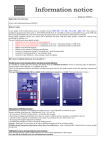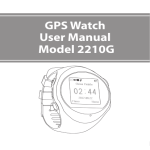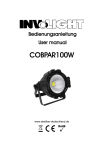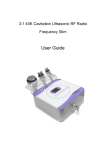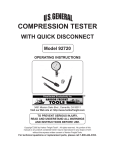Download Chicago Electric 90636 User's Manual
Transcript
100 AMP LOAD BA TTER Y AND BATTER TTERY CHARGING SYSTEM TESTER 90636 OPERATING INSTRUCTIONS ® 3491 MISSION OAKS BLVD., CAMARILLO, CA 93011 VISIT OUR WEB SITE AT HTTP://WWW.HARBORFREIGHT.COM © Copyright 2003 by Harbor Freight Tools®. All rights reserved. No portion of this manual or any artwork contained herein may be reproduced in any shape or form without the express written consent of Harbor Freight Tools. For technical questions and replacement parts, please call 1-800-444-3353. SPECIFICATIONS Item Capability Load Test Capacity Display Meter Test Cycle Battery Cable / Clamps Overall Dimensions Features Description 6 and 12 VDC battery tester with charging system output 100 amps; 50~1000 cold cranking amps Analog, 0~16 VDC (maximum) 10 seconds per test with 1 minute cool down; 3 tests in 5 minutes 16-3/4 inch; Copper plated clamps 12-3/4 (L) x 6 (W) x 3 (D) inches Carrying handle and four rubber feet Save This Manual You will need the manual for the safety warnings and precautions, operating and maintenance procedures. Keep your invoice with this manual in a safe and dry place for future reference. SAFETY PRECAUTIONS WARNING! READ AND UNDERSTAND ALL INSTRUCTIONS. Failure to follow all instructions listed below may result in electric shock, fire, and/or serious injury. SAVE THESE INSTRUCTIONS 1. Keep your work area clean and well lit. Cluttered benches and dark areas invite accidents. 2. Do not operate power tools in explosive atmospheres, such as in the presence of flammable liquids, gases, or dust. Power tools create sparks which may ignite the dust or fumes. 3. Keep bystanders, children, and visitors away while operating a power tool. Distractions can cause you to lose control. Protect others in the work area from debris such as chips and sparks. Provide barriers or shields as needed. 4. Do not force the tool. Use the correct tool for your application. The correct tool will do the job better and safer at the rate for which it is designed. 5. Do not use the power tool if the Power Switch does not turn it on or off. Any tool that cannot be controlled with the Power Switch is dangerous and must be replaced. 6. Store idle tools out of reach of children and other untrained persons. Tools are dangerous in the hands of untrained users. SKU 90636 For technicial questions, please call 1-800-444-3353. Page 2 7. Maintain tools with care. Keep clean. Do not use a damaged tool. Tag damaged tools “Do not use” until repaired. 8. Tool service must be performed only by qualified repair personnel. Service or maintenance performed by unqualified personnel could result in a risk of injury. 9. Maintain labels and nameplates on this tool. These carry important information. If unreadable or missing, contact Harbor Freight Tools for a replacement. 10. Always wear ANSI approved safety impact eye goggles and heavy work gloves when using this tool. Using personal safety devices reduce the risk for injury. Safety impact eye goggles and heavy work gloves are available from Harbor Freight Tools. CAUTION! Battery acid may cause severe injury to eyes; always wear ANSI approved safety goggles. Avoid touching eyes while working with or near a battery. In case of accidental contact, rinse eyes with clean water for at least 5 minutes and see a doctor immediately. 11. Maintain a safe working environment. Keep the work area well lit. Make sure there is adequate surrounding workspace. Always keep the work area free of obstructions, grease, oil, trash, and other debris. Do not use this tool in areas near flammable chemicals, dusts, and vapors. Do not use this product in a damp or wet location. WARNING! People with pacemakers should consult their physician(s) before using this product. Operation of electrical equipment in close proximity to a heart pacemaker could cause interference or failure of the pacemaker. SPECIFIC SAFETY RULES FOR THE BATTERY TESTER 1. When connecting the Battery Cables to the battery, avoid creating sparks (always connect and disconnect clamps exactly as described in rule number 2, below, and on page 4), especially when the battery is being charged. Explosive gases are created during charging. Sparking could also damage the vehicle electrical system. 2. Be certain of the test battery polarity before connecting the test Cable Clamps. The red Cable Clamp (A) goes to the positive terminal of the battery. The black Cable Clamp (B) goes to the negative terminal of the battery. 3. When placing the Battery Tester in the vehicle (on the frame, engine, or fender), take special care that the metal housing of the Battery Tester does not come in contact with either terminal of the battery or other electrical connections. 4. Do not drop the Battery Tester as it may affect proper operation. 5. Do not smoke or have open flames near the battery. SKU 90636 For technicial questions, please call 1-800-444-3353. Page 3 6. Reversing Battery Tester Cable Clamps on the battery will damage the tester. 7. Do not connect the Battery Tester to the battery while the battery is being charged. Turn the engine off before connecting. 8. Do not touch the cooling vents on the Battery Tester immediately after testing the battery. They become very hot. UNPACKING When unpacking, check to make sure that all the parts are included. Refer to the Assembly section, and the Assembly Drawing and Parts List at the end of this manual. (A) (D) (C) (B) If any parts are missing or broken, please call Harbor Freight Tools at the number on the cover of this manual as soon as possible. OPERATING INSTRUCTIONS Testing the Battery CAUTION! Undercharged lead-acid batteries will freeze during cold weather. NEVER TEST OR CHARGE A FROZEN BATTERY. 1. To help ensure a good connection, clean battery terminals with a solution of baking soda and water, and wipe the battery terminals with a cloth to remove any dirt and grease. 2. Connect the red (positive) Cable Clamp (A) to the positive terminal (+) on the 6 or 12 V lead-acid battery. (See photo above.) 3. Connect the black (negative) Cable Clamp (B) to the negative terminal (–) on the battery. Turn clamps slightly to ensure a good connection. 4. With the clamps connected, the tester’s gauge will show the battery’s current charge. If it is less than 12 V, disconnect the battery and recharge before testing. If recharging will not bring the reading above 12 V the battery is defective. If it shows no reading, verify that the tester is connected properly. If the tester is connected properly, the battery is defective. 5. Press (and hold) the Toggle Switch (C) for at least 5 seconds to simulate an actual load on the battery. SKU 90636 For technicial questions, please call 1-800-444-3353. Page 4 6. View the Meter Display (D) and read the battery condition. Refer to the “Battery Condition Analysis” section below. 7. Release the Toggle Switch (C) and remove the Cable Clamps from the battery. Testing the Charging System Note: The engine should be at normal operating temperature during this test. 1. Connect the Cable Clamps (A, B) to the battery as previously described. 2. Outside, or in a well ventilated area, start the vehicle engine and run at fast idle speed. Never start and run the vehicle’s engine in a closed garage. WARNING! Avoid Carbon Monoxide poisoning. This gas comes from the vehicle exhaust and is colorless and odorless. It can cause serious injury or death if inhaled. Never run the vehicle’s engine inside a garage or any other enclosed space. 3. View the Meter Display (D) and read the charging system condition (far right on the gauge). Refer to the “Battery Condition Analysis” section below. CAUTION! DO NOT press the Toggle Switch (C) during this test. Battery Condition Analysis LOAD TEST / 5 Sec. (Display Reading) BATTERY CONDITION OK (green area) Batter y capacity is good. May or may not be fully charged. Check the charge state by testing the Specific Gravity (SG) with a Hydrometer. If SG is less than full charge, check for possible charging system trouble. Recharge to full level. WEAK (yellow area) If the Display Meter needle is steady, the batter y capacity is not good. Batter y may be defective or par tly discharged. Check SG. If over 1.225, the batter y is defective. If below 1.225, recharge batter y and re-test.If there is a difference in SG between cells over 2 points (0.025), a par ticular cell may be damaged. If charging does not bring SG to full charge level, then batter y is either sulfated, or has lost its active material. BAD (red area) If the Display Meter needle is falling, the batter y is defective or has a bad cell. For a quick check, release the load Toggle Switch and note Display Meter reaction. If voltage recovers to its full potential after only a few seconds, the batter y is probably defective. If the voltage recovers slowly, the batter y may only be run down. Check SG, recharge, and re-test. CHARGING SYSTEM (white area) If the Display Meter needle reads OK, charging system is functional. If it falls on the low red or high red areas, charging system may be malfunctioning. SKU 90636 For technicial questions, please call 1-800-444-3353. Page 5 Testing the Starter Note: The engine should be at normal operating temperature and the battery should be fully charged before doing this test. 1. Connect the Cable Clamps (A, B) to the battery as previously described. 2. Disable the ignition so the engine will not start. (Refer to your vehicle’s manual.) 3. Have an assistant crank the engine. Note the voltage reading during cranking. 4. View the Meter Display (D) and read the voltage. A reading of 9 Volts or less indicates excessive current draw. This may be due to a poor connection, a failing starter, or a battery of insufficient size for the motor. CAUTION! DO NOT press the Toggle Switch (C) during this test. INSPECTION, MAINTENANCE, AND CLEANING 1. Periodically recheck all nuts, bolts, and screws for tightness. 2. Store in a clean and dry location. 3. Clean the outside of the unit with a damp cloth. Never use solvents to clean any part of this tool. Use compressed air to blow out debris from the load vents. 4. After each use, clean the Cable Clamps of any possible battery electrolyte. Apply a thin coat of silicon grease to prevent corrosion. REPLACEABLE PARTS The Battery Tester has no replaceable parts. PLEASE READ THE FOLLOWING CAREFULLY THE MANUFACTURER AND/OR DISTRIBUTOR HAS PROVIDED THE PARTS DIAGRAM IN THIS MANUAL AS A REFERENCE TOOL ONLY. NEITHER THE MANUFACTURER NOR DISTRIBUTOR MAKES ANY REPRESENTATION OR WARRANTY OF ANY KIND TO THE BUYER THAT HE OR SHE IS QUALIFIED TO MAKE ANY REPAIRS TO THE PRODUCT OR THAT HE OR SHE IS QUALIFIED TO REPLACE ANY PARTS OF THE PRODUCT. IN FACT, THE MANUFACTURER AND/OR DISTRIBUTOR EXPRESSLY STATES THAT ALL REPAIRS AND PARTS REPLACEMENTS SHOULD BE UNDERTAKEN BY CERTIFIED AND LICENSED TECHNICIANS AND NOT BY THE BUYER. THE BUYER ASSUMES ALL RISK AND LIABILITY ARISING OUT OF HIS OR HER REPAIRS TO THE ORIGINAL PRODUCT OR REPLACEMENT PARTS THERETO, OR ARISING OUT OF HIS OR HER INSTALLATION OF REPLACEMENT PARTS THERETO. REV 07/04 SKU 90636 For technicial questions, please call 1-800-444-3353. Page 6






